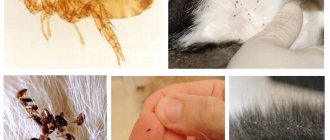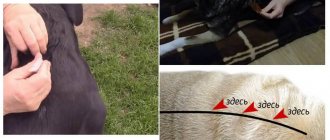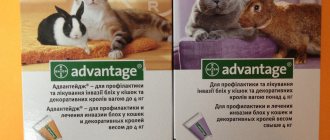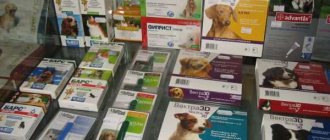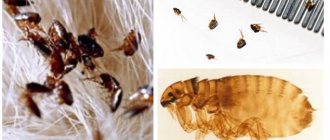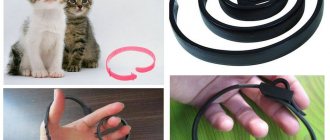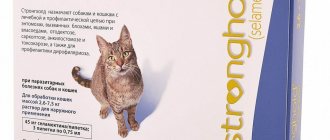Composition and pharmacological properties
BARS® drops against fleas and ticks for cats contain fipronil - 10 mg/ml, diflubenzuron - 1 mg/ml and dicarboximide (MGK-264) - 1 mg/ml as active ingredients, as well as excipients.
BARS® drops against fleas and ticks for dogs contain fipronil – 50 mg/ml, diflubenzuron – 1 mg/ml and dicarboximide (MGK-264) – 5 mg/ml and excipients as active ingredients
The mechanism of action of fipronil, which is part of the drug, is to block GABA-dependent ectoparasite receptors, disrupt the transmission of nerve impulses, which leads to paralysis and death of ectoparasites. Diflubenzuron, by inhibiting the synthesis of chitin in parasites, disrupts the process of molting, oviposition and hatching of larvae from eggs, which leads to a cessation of population replenishment. Dicarboximide is a synergist and is used with insecticides to increase their activity. Dicarboximide stops microsomal detoxification of the insecticide, increasing its toxicity to the parasite.
After skin application of the drug, the active substances included in its composition, without being absorbed into the systemic bloodstream, are evenly distributed over the surface of the body, accumulate in the sebaceous glands, long-term protecting the animal from ectoparasites.
Insectoacaricidal drops "Bars" in terms of the degree of impact on the body are classified as moderately hazardous substances; in recommended doses they do not have a resorptive-toxic, locally irritating or sensitizing effect; Causes irritation upon contact with eyes. The drug is well tolerated by dogs and cats of different breeds and ages, but is toxic to rabbits, as well as fish and other aquatic organisms.
Insectoacaricidal drops for cats Bars Forte, three pipettes
Composition and pharmacological properties. The drug contains fipronil and an insect growth regulator and has pronounced activity against the larval and mature phases of development of fleas, lice, lice, ixodid and sarcoptic ticks that parasitize dogs and cats. After cutaneous application of the drug, fipronil, which is part of it, is not absorbed into the systemic bloodstream, accumulates in the epidermis, hair follicles and sebaceous glands of the animal’s body and has a long-term contact insectoacaricidal effect. The mechanism of action of fipronil is to block GABA-dependent ectoparasite receptors, disrupting the transmission of nerve impulses, which leads to paralysis and death of insects and ticks. The insect growth regulator disrupts the synthesis of chitin in parasites and thus breaks their life cycle. Indications for use. For dogs and cats for therapeutic and prophylactic purposes against entomosis (lice, fleas, lice), sarcoptic mange, notoedrosis and ixodid ticks, as well as to prevent attacks of ectoparasites on animals. Contraindications. Pregnant and lactating females, patients with infectious diseases and convalescent animals, puppies and kittens under 8 weeks of age cannot be treated. Side effects. When using the drug according to the instructions, no side effects or complications are observed. If the animal's individual sensitivity to fipronil is increased and complications occur (excessive salivation, lacrimation, vomiting), treatment of the animal is stopped and the drug is washed off with water and detergent. Doses and order of application. Apply by droplet application to dry, intact skin once. The duration of the protective effect of the drug lasts for 1–2 months. The drug is applied to places inaccessible to licking by animals: on the skin at several points in the back between the shoulder blades or in the neck at the base of the skull in the doses indicated in the table. The minimum therapeutic dose of the drug for dogs is 0.18 ml/kg of animal weight, which corresponds to 9 mg/kg of fipronil and 0.18 mg/kg of diflubenzuron, for cats – 0.1 ml/kg of animal weight, which corresponds to 5 mg /kg fipronil and 0.1 mg/kg diflubenzuron. Taking into account the type and weight of the animal being treated, dropper pipettes of the required volume or combinations thereof are selected and the drug is used in the doses indicated in the table.
Doses and order of application
Apply to animals once by drip application to dry, intact skin at several points in the back between the shoulder blades or in the neck at the base of the skull (in places inaccessible to licking by animals) in doses indicated in the table.
| Type and weight of the animal | Volume of the drug in the pipette, ml | Drug dose, ml per animal | Number of pipettes required for processing, pieces | |
| Cats | ||||
| up to 1 kg | 1,0 | 0.3 (10 drops) | 1 | |
| from 1 to 3 kg | 1,0 | 0.6 (20 drops) | 1 | |
| from 3 kg or more | 1,0 | 1,0 | 1 | |
The protective effect of the drug lasts for 1-2 months. Repeated treatments of animals are carried out according to indications, but not more than once a month.
When treating otodectosis, the auricles and ear canal are first cleaned of earwax, exudate and scabs, then 4-6 drops of the drug are instilled into each ear. To distribute the drug evenly, the auricle is folded lengthwise and its base is lightly massaged. The remainder of the drug in the pipette is applied to the animal’s skin between the shoulder blades. In advanced cases of otodectosis, complicated by otitis, antibacterial and anti-inflammatory drugs are prescribed and the auricular application of BARS® drops against fleas and ticks is repeated after 7-10 days.
The drug must be administered into both ears, even in cases of otodectosis affecting only one ear.
To prevent splashing of the drug (if the animal shakes its head), the animal's head should be fixed for several minutes.
In order to prevent re-infestation with fleas, the animals' bedding is replaced or the floors of the premises are treated with any insecticidal agent in accordance with the instructions for its use.
Composition and release form
The manufacturer of “Bars” flea drops is Scientific and Implementation Center (abbreviated name “AVZ”), Russian Federation.
The drug is an oily yellowish flavored liquid. The main active ingredient in Bars drops is fipronil . In addition, the drug also contains diflubenzuron and dicarboximide, but the amount of each of these two substances is ten times less than the main one.
Bars drops are produced separately for cats and dogs. These drugs, in principle, are interchangeable (in fact, they are one and the same drug), but experts still recommend using the “cat” version for treating cats, and the “canine” version for treating dogs, since the dosage in them is specially selected for the corresponding species animals.
The drops themselves are initially packaged by the manufacturer in disposable pipettes made of polymer material. The amount of substance in each is 1 ml.
Important! “Bars” drops for dogs are packaged in droppers of 1.4 ml, for an adult medium-sized cat this is a lot, and for two - very little, which is why, in order to avoid an overdose or a decrease in the protective effect due to an insufficient dose of the drug, it should buy drops for the animal for which they are intended.
Pipettes (or droppers) are sold in cardboard boxes of three or four pieces. Each box also contains instructions for using the drug, which, it should be noted, are very clear and informative.
Regardless of how many pipettes are in the box, they are sold individually, so the buyer does not need to stock up on the drug for the whole season - he can buy a single dose necessary to treat the pet, and, if necessary, read the instructions directly in the store.
Bars Forte drops on sale .
They cost about 30% more, but provide longer-lasting protection, and they also contain a pest growth regulator, which further prevents their development on the skin of a cat (or dog).
For owners of kittens aged eight weeks to one year, a reduced dose of the drug is provided. Its price is lower than regular drops, but each pipette contains not 1 ml, but 0.5 ml of the drug. This version also has a forte variant.
Dosage and instructions for use
The drug Bars has a large list of indications, and the method of its use depends primarily on the specific problem. In any case, before using the product, you need to check its suitability. The shelf life of the drops is 2 years from the date of manufacture, subject to compliance with storage rules (place protected from moisture and bright light, temperature not lower than 0 and not higher than 30 degrees).
General processing
Drops for cats are available in one volume option - 1 ml droppers, but the amount of the drug for treating a particular animal is determined based on its weight:
- for pets weighing up to 1 kg, 10 drops, that is, 0.3 ml, will be enough;
- for cats up to 3 kg, a single dose is 20 drops, or 0.6 ml;
- for those cats that weigh more than 3 kg, you will need a whole bottle, that is, 1 ml of the drug.
When preparing for the procedure, you need to remember that you should not bathe your cat for 72 hours before the procedure. The same time must be maintained after applying the drops. The animal is processed at one time and involves the following steps:
- It is necessary to secure the cat so that it cannot escape during the procedure.
- The fur at the treatment site must be pulled apart to reach the skin. Places for application should be such that the pet cannot lick themselves there, so drops are applied to the neck at the base of the skull and in the area between the shoulder blades.
Drops from parasites are applied to places where the cat cannot lick them off - on the neck at the base of the skull and between the shoulder blades
- The dropper is opened and the required amount of the drug is applied, distributing it over the entire prepared strip.
Drops are applied directly to the skin, and then the composition itself disperses over the surface of the animal’s body. Absorption into the bloodstream and systemic action does not occur. The accumulation of components occurs in the hair follicles and sebaceous glands, which allows for prolonged action and protection against external parasites for one month. Repeated treatment should be done no more than once every 4 weeks.
Video: how to properly treat a cat against fleas with drops
Treatment of otodectosis
When using the drug to treat ear mite infestation, you will need to treat the ears directly:
- The ears are cleaned with a damp cotton pad to remove dirt and wax.
The first step is to clean your pet's ears.
- After this, add 4-5 drops of the product.
- In order for it to be well distributed, after processing the shell itself needs to be folded lengthwise and massaged a little.
An important aspect is that both ears should be treated at once, even though symptoms are observed only on one side.
Destruction of ticks
If an ixodid tick (a blood-sucking parasite) was found on the cat’s body, then the drops will help destroy it. The application in such a situation is as follows:
- Part the fur at the site of the bite to gain access to the attached parasite.
- Apply the drug from a pipette to the site where the tick attaches to the skin. One drop is enough for one insect.
- Within half an hour the goal will be achieved - the tick will most likely fall off on its own. If this does not happen, then it is recommended to carefully pull it out yourself and destroy it.

